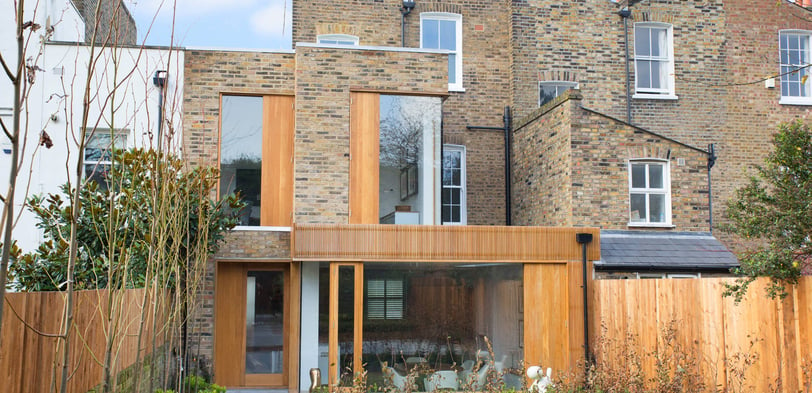Double Storey Rear Extension Ideas UK – Smart Design Tips & Costs for 2025
5/22/20254 min read


Double Storey Rear Extension Ideas UK—Design Trends, Costs & Planning Guide (2025)
With UK homeowners increasingly looking to expand rather than relocate, a double storey rear extension has emerged as one of the most valuable and space-efficient ways to transform a property. Whether you're in a terraced London home, a semi-detached house in Manchester, or a detached property in Surrey, building upwards as well as outwards gives you twice the internal space—without eating up too much garden.
In this guide, we’ll explore the best double storey rear extension ideas in the UK, along with planning advice, cost breakdowns, building regulations, and 2025 design trends.
What Is a Double Storey Rear Extension?
A double storey rear extension involves adding two levels to the back of your house—typically expanding both the ground floor and first floor. It’s an ideal solution for homeowners who need:
An extra bedroom and en suite
A larger kitchen and open-plan living space
A dedicated office or guest room upstairs
Utility areas, family rooms, or downstairs toilets
🏗️ Do You Need Planning Permission?
In most cases, yes—a double storey extension will require full planning permission in the UK. While single-story rear extensions can fall under Permitted Development, going above ground level introduces stricter rules.
📝 Key Planning Rules (as of 2025):
The extension must not exceed 3 metres beyond the rear wall of the original house (in most cases).
It must be at least 7 metres from the rear boundary if two storeys.
Materials must be in keeping with the existing house.
Overlooking neighbours (via windows or balconies) is restricted.
The roof pitch must match or be similar to the existing roof.
Homes in conservation areas or listed properties face stricter limits.
It’s important to submit full architectural drawings and get written approval before beginning construction. In many councils, pre-application advice is available and recommended.
Building Regulations and Structural Considerations
Even if your extension receives planning permission, you must also meet building regulations, covering:
Structural stability (steel beams, foundations, walls, roof load)
Fire safety (compartmentalisation, escape routes)
Thermal efficiency (insulation, glazing performance)
Soundproofing between floors and walls
Drainage and damp-proofing
Safe access to upper floors (staircases, headroom)
You’ll need to work with a qualified architect and a structural engineer and submit either a full plans application or a building notice to your local authority or an approved inspector.
Double Storey Rear Extension Design Ideas for UK Homes (2025)
Here are some smart and stylish ways to use the extra space created by a double storey rear extension:
Open-Plan Kitchen + Upstairs Master Suite
Extend your kitchen into a bright, modern open-plan area with bifold doors, skylights, and dining space. Upstairs, create a large master bedroom with built-in wardrobes and an en suite.
Utility + Extra Bedroom
Use the ground floor for practical features like a utility room, boot room, or downstairs toilet. The upper floor becomes a fourth bedroom—perfect for guests, children, or a growing family.
Office Below, Playroom Above
Ideal for work-from-home households: the bottom floor becomes a home office with garden views, while the upper level creates a children’s den or homework zone.
Library Lounge + Reading Nook
Add a rear living space that opens to the garden, with book-lined walls and a fireplace. On the first floor, create a quiet reading room or home library with rooflights and built-in shelving.
Family Bathroom + Lounge Extension
Add a full-sized family bathroom above and a larger lounge or media room below—a great way to balance private and shared space.
Two Extra Bedrooms
For large families or HMOs, a double storey extension can add two new bedrooms, increasing occupancy or rental potential significantly.
How Much Does a Double Storey Rear Extension Cost in the UK?
In 2025, the average cost per square metre for a double storey extension ranges between £2,000 and £3,000, depending on location, complexity, and finish.
A 20–30m² extension typically costs between £50,000 and £90,000.
In London and the South East, expect a premium of 10–25% due to labour and material rates.
High-spec finishes, large glazing, smart heating, or bespoke joinery can increase costs.
Other considerations:
Architect and structural engineer fees: £3,000–£6,000
Planning permission application: ~£250
Building regulations and inspections: ~£500–£1,000
Party Wall Agreement (if attached): £700–£1,500
💡 Tip: Always factor in a 10–15% contingency budget for unexpected costs during construction.
Will It Add Value?
Yes—when done well, a double storey extension can add up to 25% to your home’s market value. This is particularly true in high-demand urban areas or for homes that lack a sufficient number of bedrooms or modern kitchen space.
Buyers are drawn to larger kitchens, ensuite bedrooms, and flexible floor plans—all of which a double storey rear extension delivers.
Tips Before You Start
✅ Consult with an architect early to maximise the space and light
✅ Consider how the extension will affect internal flow — not just the new rooms
✅ Choose materials that complement your existing house
✅ Engage with neighbours early if planning permission or party walls are involved
✅ Be realistic about timeframes—expect at least 4 to 6 months from design to completion
Final Thoughts
A double storey rear extension is one of the most transformative projects you can undertake as a UK homeowner. It expands both living and sleeping areas, improves lifestyle flexibility, and significantly boosts resale value. While the planning and construction process is more complex than a single-storey build, the results are often life-changing.
Whether you want a luxurious open-plan ground floor and a dreamy master suite above, or simply need more room for a growing family—this extension style can deliver it all in one go.